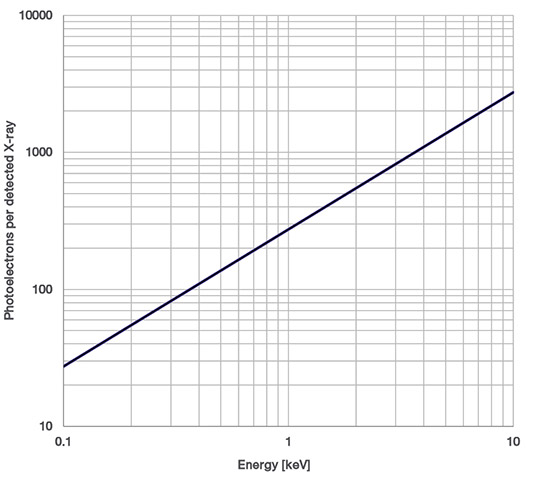Resources
 Part of the Oxford Instruments Group
Part of the Oxford Instruments Group
Expand
Collapse
 Part of the Oxford Instruments Group
Part of the Oxford Instruments Group
SOLIS software (or similar control software) will present the data from the camera as digital counts (ADU). Here we discuss the methodology for linking ADU values to the approximate number of incident X-ray photons on the sensor for SO and SY direct high energy detection (HED) cameras.
There will be a DC offset applied to the baseline of each camera. This offset level will vary for various camera / sensor types, as well as a small variation from camera to camera. This will need to be subtracted from the signal level in order to ensure that only the actual ‘useful’ signal is being measured. The simplest way to determine this baseline will be to acquire a dark image (or background). This dark / background image can be subsequently subtracted from a signal image to only display the true ‘useful’ signal ADU count level.
In order to then convert this number of photoelectrons to the number of incoming photons, this value is multiplied by the QE (in %) of the CCD/ EMCCD/ sCMOS sensor at the photon energy of interest.
This QE data is available in the specification sheets for all camera types, which are freely available for download from the Andor website.
If you require further information or assistance, please contact your local Andor Product Support representatives [1].
The photoelectrons per incoming X-ray photon energy graph shown on fig. 1 is modelled on the following data[2]:
| Incoming photon energy [keV] | Photoelectrons generated per detected X-ray |
| 0.1 | 27 |
| 1 | 274 |
| 10 | 2740 |

Figure 1 - Number of photo-electrons generated at a CCD/EMCCD/sCMOS sensor as a function of incoming x-ray photon energy
[1] Product Support - http://www.andor.com/ContactSupport.aspx?type=s
[2] Technical Note - direct x-ray detection http://www.andor.com/learning-academy/direct-detection-understand-direct-detection-ccds
Date: April 2023
Author: Andor Product Support
Category: Technical Article
